Problems of ergogenous methods and techniques of training in theory and practice of elite sport
Фотографии:
ˑ:
N.I. Volkov, professor, Dr.Biol.
B.A. Dyshko, professor, Dr.Biol.
Y.A. Voitenko
R.V. Tambovtseva, professor, Dr.Biol.
Russian state university of physical culture, sport, youth and tourism (SCOLIPC), Moscow
Sport Technology, Moscow
Key words: records, elite sport, training device.
Introduction. According to the ongoing historiographical studies, the growth of records in different sports, where the conditions for a strict quantitative analysis of the observed changes in record achievements are met under the influence of applied training means and methods, improvement of records in these sports can be represented as an exponential curve with ever decreasing decay rate constant [1-6]. The use of a new training method provokes a quite rapid improvement of record achievements in the first 5-6 years, followed by slower growth and a stop.
This situation can be illustrated by the dynamics of the growth of world records in 5000 meter run from 1900 to 2000 (Fig. 1), where the "abrupt" nature of adaptive changes is clearly visible in terms of athletes’ physical working capacity. Every next "surge" of record growth in this kind of run can be precisely linked to the use of specific training methods applied at that time.
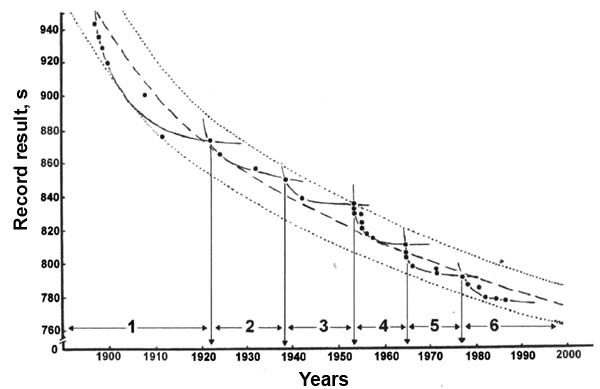
Fig. 1. Growth curve of world records in 5000 m run
The observed changes in the dynamics of record achievements in response to the application of every new training method fully corresponds to the common rule governing the development of physiological adaptation in relation to the changing amount and nature of applied physical load. It is known [6-9], that adaptive changes in the body, provoked by every new kind of training exposure, gradually decrease due to the development of adaptive changes in the body which prevents from achieving the desired training effect.
This rule is clearly visible on the logarithmic graph of the dynamics of world records in 5000 meter run from 1900 to 2000 (Fig. 2).
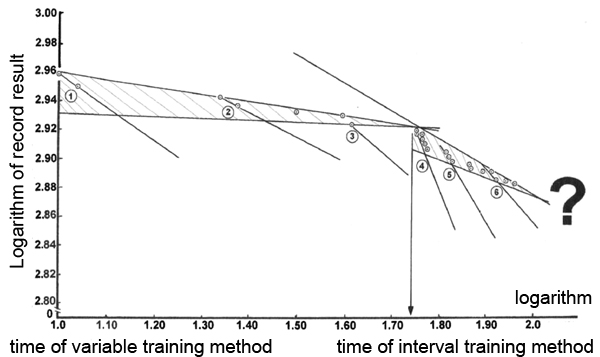
Fig. 2. Growth curve of world records in 5000 meter run (A) and during the 20th century at the logarithmic chart
As seen from the adduced graph, in the logarithmic transformation of the growth curve of records the points of new achievements within each "surge" tend to "be pushed to the limit” on a single straight line (Fig. 2). The slope of this line characterizes the relative speed of improvement of records for the training period being analyzed.
If to connect with a straight line the points located at the beginning of each “record surge" and the points of the most pronounced deviations located at the end of the "surge", then two tapering "spaces of possible improvement of records” are formed on Fig. 2, that correspond to the dominant methods of training of athletes for a considered time space [7, 10]. Temporary points, where the moments of crossing straight lines limiting the "space of the possible improvement of records" are localized, share single historical periods in the development of this sport, referring to a dominant training method.
Fig. 2 shows that six different "dominant" training methodologies have changed in the practice of training 5000 meter runners for the period of existence of the modern Olympics since 1896. The first three have dominated until the mid-20th century, and this period can be described as "an era of continuous and repeated training methods".
Another methodological revolution in the system of training of the leading world runners occurred in the early 50s of the 20th century. This revolution was associated with the practical application of training of elite athletes as a "dominant" training method of several options of repeated interval work. This period ended in the early years of this century, and it can be described as "an epoch of interval training" [11].
The purpose of the study was to make an ergometric analysis of the dynamics of world records in running at various distances in elite sport.
Results. Currently we are witnessing once again emerging as a dominant methodology of training of athletes comprehensive use of ergogenic methods and this period can be described as "an era of comprehensive ergogenic training” (Tab. 1).
Table 1. Indicators of relative speed of improvement of record results and duration of individual periods of abrupt improvement of records in 5000 meter run.
|
№ |
Period and dominant training method |
Years |
Constant of growth rate of records in running, 1/years |
Total increment of record result |
Initial result, s |
Duration of period, years |
|
1 |
Method of long-term continuous work |
1897-1922 |
0.185 |
119.0 |
994.0 |
25 |
|
2 |
Method of repeated - interval work |
1922-1939 |
0.189 |
26.2 |
875.0 |
17 |
|
3 |
Method of continuous work (“fartlek”) |
1939-1954 |
0.126 |
11.6 |
848.8 |
15 |
|
4 |
Interval training using “Freiburg rule” |
1954-1965 |
0.260 |
22.6 |
837.2 |
11 |
|
5 |
Coupled interval training |
1965-1997 |
0.314 |
21.7 |
814.6 |
12 |
|
6 |
Integrated ergogenic training |
1997-2008 |
0.154 |
14.9 |
792.9 |
15 |
Over 100 years of existence of modern Olympic sport trainers and athletes have went over and tested in practice all available possible combinations of the basic parameters of physical load, namely: type of exercises, their intensity and duration, number of repetitions and duration of rest pauses. In order to make and fix a new surge of record achievements in selected sport, it is necessary to find new, not used before ergogenic means and methods of training, or find effective combinations of new, non-traditional for this sport training methods with the old ergometric training methods [12].
By now the following methodologies of directed ergogenic exposure are science-based and implemented into sports practice including: physiological, pharmacological, nutritional, psychogenic, technogenic and bioclimatic [1].
However, it should be noted that training effects from the use of stipulated above ergogenic methodologies differ in (methodologies) temporal characteristics inherent in them. From this point of view, the effectiveness of these ergogenic methodologies should be quantified by the degree of impact of these methodologies on the urgent, delayed and cumulative training effects [7, 13].
The most accurate estimates of the achieved training effect can be obtained based on the analysis of changes in bioenergetic abilities of an athlete’s body [6].
It is known that three main characteristics that describe achieved ergogenic effect - power, capacity and efficiency, are usually quantified in the metabolic energy sources of human movement. The training effect achieved is largely dependent on the volume, intensity and direction of the impact of the training load performed [15, 16].
Special training devices, specifically affecting the characteristics of a person’s cardiorespiratory system, both in a static position, and when doing training exercises of varying intensity, were started to be used in the training practice of elite athletes since the 80s of the 20th century. These devices affect the respiratory function either by using additional load on the respiratory muscles, or by changing the composition of the inhaled air mixture [14].
The respiratory training devices of the integrated effect on the athletes’ respiratory system, designed and produced by the scientific and production company "Sport Technology" under the trademark "New Breath” (further Training device), are of particular interest among these devices. One of the latest products of this type, being effectively applied in training of elite swimmers, is shown in Fig. 3.
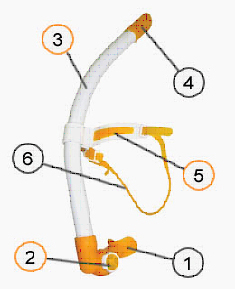
Fig. 3. Training device "New Breath” for sports and recreational swimming.
1 - case with mouthpiece, 2 - loading device with control handles, 3 - breathing tube, 4 – spray deflector, 5 - headrest, 6 - fastening belt.
The impact of the training device on the athletes’ functionalities and physical working capacity is stipulated by the co-implementation of various physical and physiological factors when doing training exercises. These factors include the mechanical resistance to the flow of the exhaled air,
low-frequency vibration of the exhaled air, as well as intensity and power of an exercise being executed.
It is shown that when performing physical load the above factors promote a remarkable improvement of the main characteristics of the breathing pattern, accelerated recovery of the indicators of pulmonary respiration and gas exchange at repeated and interval loads, increase of the indicators of aerobic and anaerobic physical working capacity of athletes.
The efficiency of using the respiratory training device is illustrated by the graphs of changes in pulmonary ventilation, oxygen utilization rate and respiratory coefficient during exercise on a bicycle ergometer with an ever-increasing power (cadence - 80 rev/min) (Fig. 4, 5, 6).
The pulmonary ventilation decrease (Fig. 4) and the increase of the oxygen-utilization coefficient (Fig. 5) at low intensity of performance of exercise when using the respiratory training device are the main reasons potentiating the functions of aerobic metabolism.
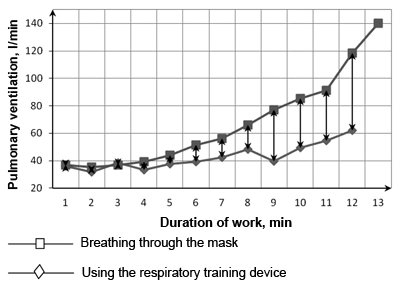
Fig. 4. Changes in the level of pulmonary ventilation when performing a graduated test load
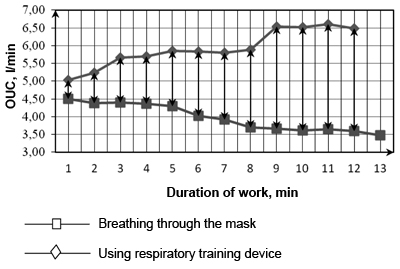
Fig. 5. The dynamics of oxygen-utilization coefficient when doing a graduated test exercise
However, the use of the respiratory training device in highly intensive exercises leads to the pronounced activation of the anaerobic glycolysis (Fig. 6).
The effect from using the Training device is also well monitored by the change in the values of the respiratory coefficient (Fig. 6). Based on the chart above, when reaching the respiratory coefficient ≥ 1.1, the slowly growing exponentially values of the respiratory coefficient at exercise of moderate intensity, not exceeding the level of anaerobic threshold, move to the rapidly increasing exponent. This phenomenon indicates the sharply increased "non-metabolic excess” CO2 at buffering of lactic acid during oxidoreduction in the anaerobic glycolysis.
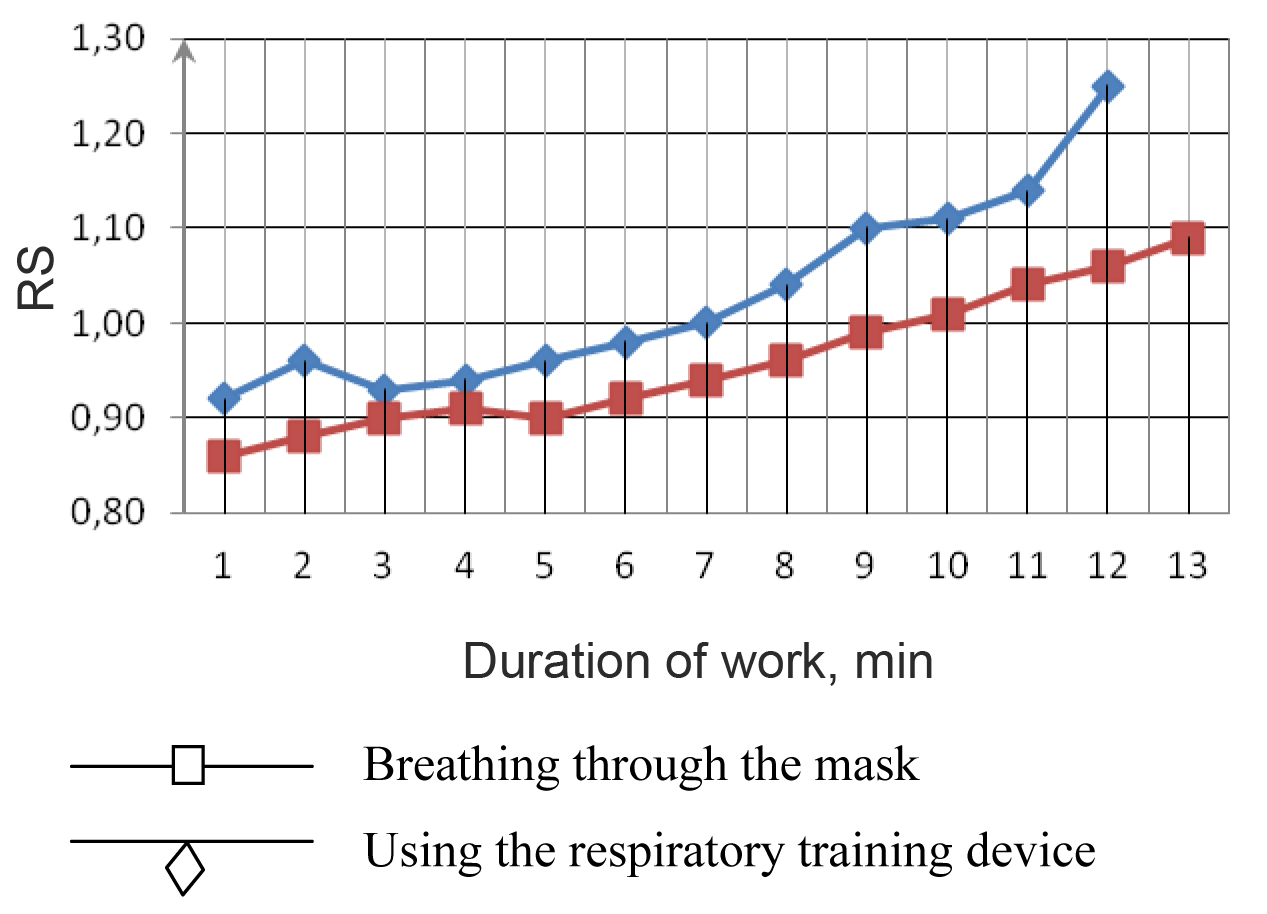
Fig. 6. The dynamics of respiratory coefficient when doing a test exercise
When exercises are performed using the Training device, the value of the training effect is easily controlled by heart rate indices, continuously recorded using a pulse monitor [17] (Tab. 2).
Table 2. The values of external respiration characteristics for users of the Training device “New Breath", depending on heart rate (HR) for beginners and professionals
|
HR (bpm) |
СО2 concentration % |
Oxygen-utilization coefficient % |
Respiratory coefficient |
|||
|
beginner |
pro |
beginner |
pro |
beginner |
pro |
|
|
90-110 |
3.0-3.9 |
3.5-3.7 |
3.0-3.8 |
3.8-4.0 |
|
0.9 |
|
110-120 |
3.9-4.1 |
3.7-3.8 |
3.9-4.1 |
3.9-4.1 |
0.93-0.95 |
0.92–0.93 |
|
120-130 |
4.1-4.2 |
3.9-4.2 |
3.95-4.2 |
4.1-4.5 |
0.97-0.99 |
0.93-0.95 |
|
130-140 |
4.1-4.3 |
4.2-4.9 |
4.1-4.3 |
4.3-5.1 |
1.0-1.06 |
0.96-0.97 |
|
140-150 |
4.2-4.4 |
4.7-5.2 |
4.2-4.3 |
5.2-5.4 |
1.08-1.5 |
0.97-1.0 |
|
150-160 |
|
5.2-5.8 |
|
5.4-5.5 |
|
1.0-1.04 |
|
160-170 |
|
5.7-6.1 |
|
5.5 |
|
1.04-1.1 |
|
170-180 |
|
6.0-6.2 |
|
5.5-5.7 |
|
1.1-1.12 |
|
180-190 |
|
6.2-6.7 |
|
5.6-5.3 |
|
1.13-1.23 |
The high efficiency of using respiratory training devices can be achieved by their combined application with different gas mixtures, pharmacological and dietary supplements, as well as specifically affecting physiotherapeutic procedures [12, 17].
The problem of strict quantitative assessment of training effect achieved depending on the type and orientation of the impact of physical load is particularly important in designing and implementing optimal ergogenic training programs for elite athletes [7, 9, 12, 13, 15]. Until the necessary experimental data base on this issue is created, it is difficult to count on a rapid resolution of the issue of designing optimal integrated ergogenic training programs for elite athletes, although there are some examples of the science-based solution of such issues [14].
Conclusions. The results of the conducted ergometric analysis of the dynamics of world records in running at various distances suggest that the improvement of sports achievements in these exercises is almost simultaneous with the change of the dominant methodical guidelines in training of athletes.
Proceeding from the analysis of the ergometric relations "speed - time" and "distance - time" in running, until the mid 50s of the 20th century the methodology of training of the world's leading runners has been improved mainly as a result of the enhanced indices of aerobic training.
As different variants of interval training were introduced into practice of training of the leading runners, special endurance started developing more actively via increasing of the athletes' anaerobic physical working capacity.
Recently the priority in the enhancement of special endurance of the world’s leading runners has shifted to the area of design and application of integrated methods of ergogenic training with various dominant variants of hypoxic training and the use of special respiratory training devices.
The contemporary "methodological revolution" in training of elite runners is realized in finding the most efficient combinations of the previously used methods and techniques and new, more perfect ergogenic methods influencing directly the development of adaptive changes in the athletes' body, the level of special endurance at a chosen running distance depends on considerably.
Efficiency of this choice in the course of the follow-up training of elite athletes depends on the extensive practical application of innovative ergogenic training technologies and conducting of thorough, quantitative monitoring of the state of athletes' aerobic and anaerobic physical working capacity.
References
- Astvand, P.-O., Bovgstrom, A. Pomquoi les records sportifs progressant –ils? In: R.H.Strauss. Medicements et performances sportives. – Paris: Masson, 1990, p. 147 – 169.
- Craig, A. Limitation of the human organism. Analysis of world records and Olympic performance// J. Sports Med., 1964, V.4., P. 142 – 152.
- Frucht, A.H., Jokl, E. Parabolic extrapolation of Olympic performance growth since 1990 // J. Sports Med., 1964, V.4, P.142 -152.
- Henry, F.M. A note on physiological limits and the history of the mile run // Research Quart., 1954, V. 25, n. 4, h.483.
- Volkov, N.I. The records of endurance: past, present, future / N.I. Volkov, S.V. Ionov // Teoriya i praktika fizicheskoy kultury. – 1994. – № 10. – P. 21–24. (In Russian)
- Volkov, N.I., Popov, O.I. Treinamento el faturio dos recodes deportivos // Treinamento Desportivo (Brasil), 1997, V.2, P. 58 – 64.
- Volkov, N.I. The rules of biochemical adaptation during sports training. – Moscow, RIE SCOLIPhC, 1986, 63 P. (In Russian)
- Volkov, N.I., Voitenko, Y., Popov, O.I. Physiological criteria of adaptation in non physical loads // Kas YY Khabaransy, biologio seriyasy, 2007, №4(34), P. 24-25.
- Volkov, N.I., Popov, O.I., Voitenko, Y. Adaptation to the effect of physical loads in athletics during training // Int. Convention on Science, Education and Modeling in Sport: Proceeding V.C.I. – 2008, P.249.
- Volkov, N.I. Ergometric analysis in sport: problems and perspectives / N.I. Volkov, O.I. Popov // Nauka v olimpiyskom sporte. – 2001. – №1. – P. 64–71. (In Russian)
- Volkov, N.I., Karasev, A.V., Khosni, M. Theory and practice of interval training in sport. – Moscow: Military academy named after F.E. Dzerzhinsky, 1995. – 196 P. (In Russian)
- Volkov, N.I. Ergogenic means in modern Olympic sport. In: Wych. Fiz. Sport (Poland), 1999, V. 43(Suppl.), P.75.
- Viry, A.A. Adaptation in sport training. – Bora Raton: CRC Press, 1995, 310 p.
- Volkov, N.I. Sports bioenergetics: monograph / N.I. Volkov, V.I. Oleynikov. – Moscow: Sovetsky sport, 2011. – 160 P. (In Russian)
- Costree, D.L., Costree, D.l., Thomas, R., Robergs, R. Adaptation to swimming training: influence of training volume // Med. Sci. Sports Exerc., 1991, V. 23, P. 371 – 377.
- Bulgakova, N.Zh. The dynamics of training loadings and indicators of special physical working capacity of young swimmers in the course of the year-round training / N.Zh. Bulgakova, N.I. Volkov, V.V. Smirnov // Nauka v Olimpiyskom sporte. – 2001. – № 1. – P. 72–80. (In Russian)
- Dyshko, B.A. Innovative technologies of training of respiratory system / B.A. Dyshko, A.B. Kochergin, A.I. Golovachev. – Moscow: Teoriya i praktika fizicheskoy kultury i sporta, 2012. – 122 P. (In Russian)
- Volkov, N.I., Popov, O.I., Voitenko, Y. Adaptation to the effect of physical loads in athletics during training // Int. Convention on Science, Education and Modeling in Sport: Proceeding V.C.I. – 2008, P. 249.
Author’s contacts: sporttec@yandex.ru

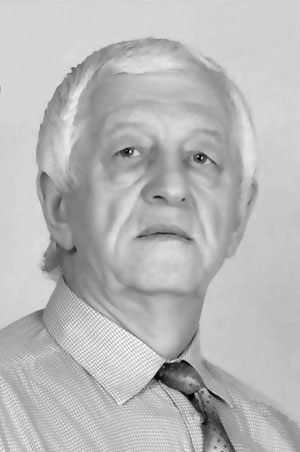

 Журнал "THEORY AND PRACTICE
Журнал "THEORY AND PRACTICE